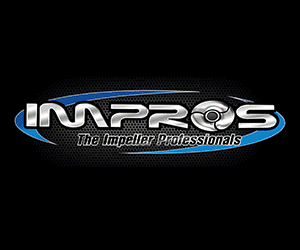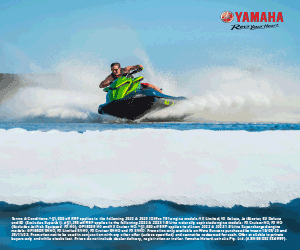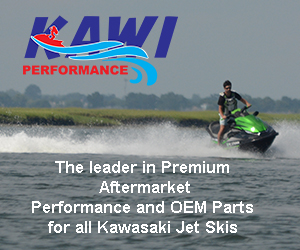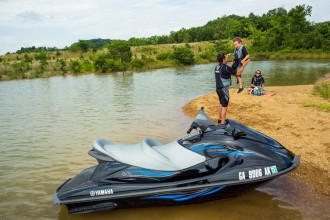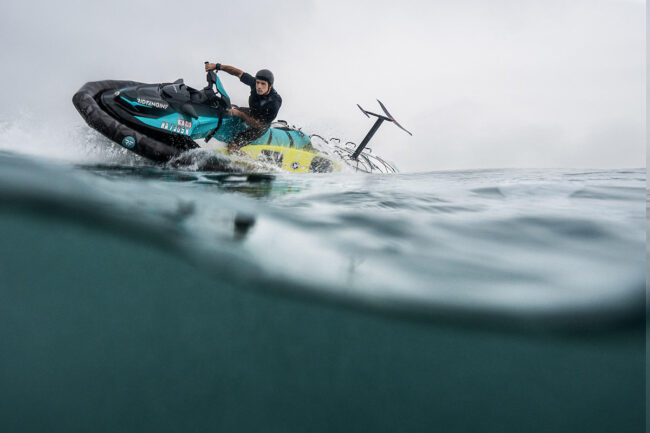 In the evolution of Personal Watercraft, inflatable collars, also known as sponsons, experienced their share of waves of popularity. The first use of these inflatable or rigid extensions on PWCs can be traced back to the 1980s. Back in the day, PWCs lacked stability compared to other watercraft. This deficiency led to safety concerns and constrained their performance potential. To tackle these challenges, engineers and enthusiasts began experimenting with modifications, including adding inflatable or rigid collars to the sides of PWC. For the most part, enthusiasts would add a short section of floatation starting from the stern and measuring 3-4 feet.
In the evolution of Personal Watercraft, inflatable collars, also known as sponsons, experienced their share of waves of popularity. The first use of these inflatable or rigid extensions on PWCs can be traced back to the 1980s. Back in the day, PWCs lacked stability compared to other watercraft. This deficiency led to safety concerns and constrained their performance potential. To tackle these challenges, engineers and enthusiasts began experimenting with modifications, including adding inflatable or rigid collars to the sides of PWC. For the most part, enthusiasts would add a short section of floatation starting from the stern and measuring 3-4 feet.
It’s important to dissociate PWC collars and PWC-boat conversions. A PWC-Boat conversion is a full-size boat that utilizes the insertion of a full-size PWC in its hull, acting as a source of propulsion. You can bring several people on board, and you can usually decide to separate the PWC from the boat and use the PWC independently.
In the case of inflatable collars, these are a simple yet permanent add-on to your PWC that provides the following enhancements:
- Stability
- Flotation
- Impact Protection
- Smoother ride in rough conditions
- Reduced bow spray
- Ability to carry more equipment
- In the event of a water infiltration emergency, the inflatable collar will ensure that your PWC remains buoyant and afloat.
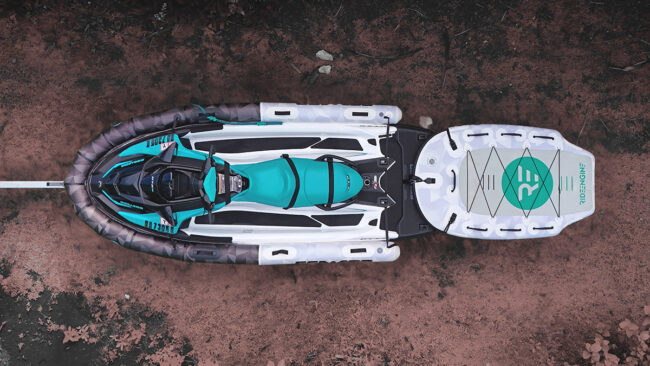 In the past three years, the use of inflatable collars has experienced a significant surge in popularity. Originating from the big wave surfing scene, athletes and rescue teams utilizing PWCs in challenging ocean conditions swiftly recognized the remarkable benefits of inflatable collars for their aquatic endeavors. When I first saw inflatable collars appearing in the big wave scene in Hawaii, I was skeptical. Even though I’d been using PWCs in big surf for over 18 years, I wasn’t convinced that this zodiac-looking device was a game changer.
In the past three years, the use of inflatable collars has experienced a significant surge in popularity. Originating from the big wave surfing scene, athletes and rescue teams utilizing PWCs in challenging ocean conditions swiftly recognized the remarkable benefits of inflatable collars for their aquatic endeavors. When I first saw inflatable collars appearing in the big wave scene in Hawaii, I was skeptical. Even though I’d been using PWCs in big surf for over 18 years, I wasn’t convinced that this zodiac-looking device was a game changer.
Back then, the brand I designed for, called Ride Engine, was already manufacturing PWC rescue sleds. These sleds, which you attach behind your PWC, not only increase the available space on your vessel, but make Search and Rescue (SAR) operations and water patrol rescues easier. I suggested the company start building some inflatable collar samples and see what it was all about.
When I first observed inflatable collars being introduced for PWC, I noticed that some brands didn’t seem to have an optimized fit. It was understandable, because with Sea-Doo, Yamaha, and Kawasaki each having different hull designs, it would be impossible for one or two collar designs to fit all perfectly. That’s why I knew we had to 3D scan the hulls of the watercraft to design bespoke inflatable collars for each hull shape. To ensure a perfect fit, the collar had to match the exact outline of the hull. It’s crucial to acknowledge that, by these pioneering brands developing early inflatable collars, even if they weren’t perfect at the time, they played a significant role in shaping how collars look and function today. Their efforts helped pave the way for the advancements we see in collar design and performance.
Once I had the first Ride Engine inflatable collar built, I installed it on my Sea-Doo GTX. You’re probably aware that the ST-3 hull of the Sea-Doo GTX is already one of the most stable on the market, being one of the longest with a lower center of gravity. I was amazed at how much the installed collar transformed the feel of the GTX. When I took it out into heavy waters in Hawaii—essentially big open seas with 30-40 miles per hour front-facing winds—I instantly noticed how much drier the ride was. I could finally take my ski goggles off! After using the GTX in rough water for two weeks straight, I decided to take the collar off to compare the difference. I was stunned by how much rougher the ride was without the collar. I found myself pounding the hull down on most of the choppy waves and getting constantly sprayed in the face. Additionally, I noticed that I had to be more cautious while navigating over small walls of whitewater now that the collar was gone.
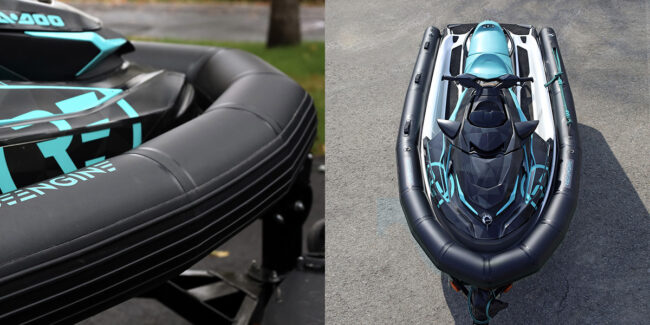 With the impressive results seen on the Sea-Doo GTX, I promptly set out to design a collar for the Sea-Doo Spark. Back home in Canada, we frequently use the Spark to access surfing river waves. As much as I truly love the dirt bike-like experience of the Spark on calm water, navigating the Spark through R1-R2 rapids often feels more like a rodeo than a joy ride. We’ve had moments where we end up rolling the Spark into the rapid, requiring us to chase it down the river. While it makes for great evening stories, we always hoped the Spark would be a bit more stable. Due to the intricate triple-stage Spark hull shape, 3D scanning the hull was crucial to designing the perfectly fitting inflatable collar. Once the first Spark collar was made and installed, my friend Yannick and I took it down a serious river rapid section, which was likely a class R2-R3 rapid at the time. With the two of us on the Spark, we were blown away by how stable it became with the inflatable collar. It was as if we could now have full confidence in the unit, especially when used in rough waters.
With the impressive results seen on the Sea-Doo GTX, I promptly set out to design a collar for the Sea-Doo Spark. Back home in Canada, we frequently use the Spark to access surfing river waves. As much as I truly love the dirt bike-like experience of the Spark on calm water, navigating the Spark through R1-R2 rapids often feels more like a rodeo than a joy ride. We’ve had moments where we end up rolling the Spark into the rapid, requiring us to chase it down the river. While it makes for great evening stories, we always hoped the Spark would be a bit more stable. Due to the intricate triple-stage Spark hull shape, 3D scanning the hull was crucial to designing the perfectly fitting inflatable collar. Once the first Spark collar was made and installed, my friend Yannick and I took it down a serious river rapid section, which was likely a class R2-R3 rapid at the time. With the two of us on the Spark, we were blown away by how stable it became with the inflatable collar. It was as if we could now have full confidence in the unit, especially when used in rough waters.
While the benefits of the inflatable collar are impressive, there are important considerations to keep in mind. Firstly, your watercraft’s turning ability will be affected. With the collar installed, you won’t be able to cut buoys as sharply as before. To execute sharp turns, you’ll need to perfect your techniques and start leaning far aside to initiate sharp turns. Additionally, the installation process can be tricky. It’s a fun project for DIY enthusiasts, but it might be challenging for those unfamiliar with using tools like drills and vice grips. Installing your first inflatable collar typically takes approximately three hours. The upside is that, for Yamaha and Sea-Doo models, you’ll need to remove the front bumper and side railing to install the collar. This means that when you’re ready to resell your PWC, you can simply remove the collar, reassemble the front bumper and railing, and it’ll be as if the collar was never there. There will be no exposed hull or permanent markings.
 foresee the market for inflatable collars growing significantly. Anyone using their personal watercraft on rough water stands to benefit from the added stability and safety provided by the collar. I personally know several fishing enthusiasts who love using the inflatable collar for their open sea fishing trips on PWCs. The potential applications extend beyond recreational use—I could write several pages about PWC rescue techniques for SAR agencies. There are numerous advantages for single PWC operator rescuers when dealing with in-water victims.
foresee the market for inflatable collars growing significantly. Anyone using their personal watercraft on rough water stands to benefit from the added stability and safety provided by the collar. I personally know several fishing enthusiasts who love using the inflatable collar for their open sea fishing trips on PWCs. The potential applications extend beyond recreational use—I could write several pages about PWC rescue techniques for SAR agencies. There are numerous advantages for single PWC operator rescuers when dealing with in-water victims.
Now, I know many of you may be wondering about the cost. Currently, there are four major brands: Ride Engine, Waterman Unlimited, One Hawaii and Wings Inflatable. The price range for most of their collars falls between $2,000 and $2,500. It’s important to consider that a significant portion of this investment, around $1,000, directly contributes to the residual value of your vessel. The collar helps prevent your PWC from getting scratched or damaged on the bumpers and railings.
It’s important to emphasize that I’m not recommending anyone venture into big waves or river rapids using Personal Watercraft. Most PWC operators navigating these conditions have honed their skills over many years, taking incremental steps and learning from experienced operators. If you’re interested in learning more about Big Wave Risk Assessment, I’m associated with a group called BWRAG, a non-profit organization with the sole mission of teaching Big Wave Risk Assessment to water enthusiasts. You can check them out for more information.










